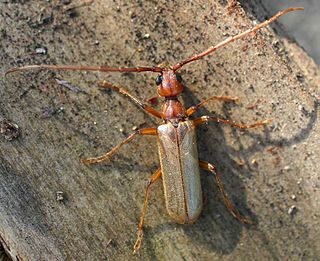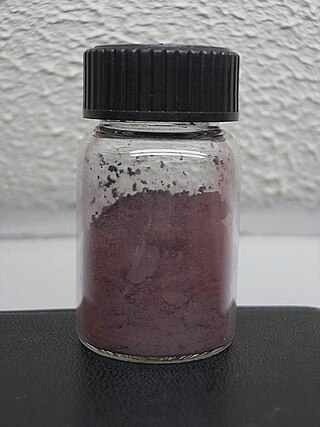Related Research Articles
Sienna is an earth pigment containing iron oxide and manganese oxide. In its natural state, it is yellowish brown, and it is called raw sienna. When heated, it becomes a reddish brown, and it is called burnt sienna. It takes its name from the city-state of Siena, where it was produced more widely during the Renaissance. Along with ochre and umber, it was one of the first pigments to be used by humans, and is found in many cave paintings. Since the Renaissance, it has been one of the brown pigments most widely used by artists.

The longhorn beetles (Cerambycidae), also known as long-horned or longicorns, are a large family of beetles, with over 35,000 species described. Most species are characterized by extremely long antennae, which are often as long as or longer than the beetle's body. In various members of the family, however, the antennae are quite short and such species can be difficult to distinguish from related beetle families such as the Chrysomelidae. The scientific name of this beetle family goes back to a figure from Greek mythology: after an argument with nymphs, the shepherd Cerambus was transformed into a large beetle with horns.

Siderite is a mineral composed of iron(II) carbonate (FeCO3). Its name comes from the Ancient Greek word σίδηρος (sídēros), meaning "iron". A valuable iron ore, it consists of 48% iron and lacks sulfur and phosphorus. Zinc, magnesium, and manganese commonly substitute for the iron, resulting in the siderite-smithsonite, siderite-magnesite, and siderite-rhodochrosite solid solution series.

Morawa is a town in the Mid West region of Western Australia. It is located within the Shire of Morawa, approximately 370 kilometres (230 mi) north of the state capital Perth, on the railway line between Wongan Hills and Mullewa.

Clevedon Shore is a 0.38 hectare geological Site of Special Scientific Interest adjacent to the Severn Estuary at Clevedon, North Somerset, notified in 1991.


The Vesperidae are a small family of beetles, normally classified within the family Cerambycidae, of heterogeneous aspect but all characterised by larval stages related to roots of herbaceous plants or trees

Lepturinae, the lepturine beetles, is a subfamily of the longhorn beetle family (Cerambycidae), containing about 150 genera worldwide. This lineage is most diverse in the Northern Hemisphere. Until recently the subfamily Necydalinae was included within the lepturines, but this has been recently recognized as a separate subfamily. Nine tribes are usually recognized today, with a tenth, Caraphiini, created in 2016. A few genera are of uncertain placement within the subfamily.

The Mumbwa Caves are an archeological site in Zambia. The site has yielded artifacts that date from the Mesolithic, Neolithic and the Iron Age. The caves are a source of stratified, in situ deposits with faunal and human remains. Mumbwa, with its interior structures, demonstrates the complexity of the behavioral abilities of the people from the Mesolithic. Selection of raw materials along with features such as hearths suggests a population which was modern in its behaviors used to inhabit the Mumbwa Caves. Study and excavation of the Mumbwa Caves is helping to fill in the gaps in the late Pleistocene prehistory of south central Africa.

The Ngwenya Mine is located on Bomvu Ridge, northwest of Mbabane and near the northwestern border of Eswatini (Swaziland). This mine is considered to be the world's oldest. The haematite ore deposit was used in the Middle Stone Age to extract red ochre, while in later times the deposit was mined for iron smelting and iron ore export.

Grammoptera is a genus of beetles in the family Cerambycidae, distributed primarily in the Northern Hemisphere.
Mount Gould Station is a pastoral lease that used to operate as a sheep station but now operates as a cattle station in Western Australia.
Grammoptera militaris is a species of beetle in the family Cerambycidae. It was described by Chevrolat in 1855.
Grammoptera rhodopus is a species of beetle in the family Cerambycidae. It was described by John Lawrence LeConte in 1874.
Grammoptera subargentata is a species of beetle in the family Cerambycidae. It was described by William Kirby in 1837.

Grammoptera abdominalis is a species of beetle in family Cerambycidae. It is found in the Palearctic The species is widespread in Europe eastward to the Caucasus. In the Nordic region, the species is very rare. The larvae develop in dead branches of oak attacked by fungi, especially the species Vuilleminia comedens, but it is possible that it is not specifically related to this species. Larvae development probably takes two years. The adults can be found in May–June, preferably on flowers.

Grammoptera ustulata is a species of beetle in family Cerambycidae. It is found in the Palearctic

Caput mortuum, also known as cardinal purple, is the name given to a purple variety of haematite iron oxide pigment, used in oil paints and paper dyes. Due to the cultural significance of its deep purple colour, it was very popular for painting the robes of religious figures and important personages, with its popularity peaking in the 18th and 19th centuries.

Tambun rock art, is a series of Neolithic-era cave paintings at the Gunung Panjang limestone hill in Tambun, on the outskirts of Ipoh, Perak, Malaysia. The paintings were discovered on a rocky overhang in 1959 by 2/Lt R. L. Rawlings of the 2nd Battalion, 6th Queen Elizabeth's Own Gurkha Rifles. Popularly known as the "Tambun Cave Paintings", the paintings could have been made by the ancestors of the Orang Asli and had spiritual importance. This site should not be confused with Gunung Tambun, another limestone hill that is found several kilometres to the north of Gunung Panjang.
References
- ↑ "ADW: Grammoptera haematites: CLASSIFICATION". Animal Diversity Web . Retrieved 2021-12-06.
- ↑ Bezark, Larry G. A Photographic Catalog of the Cerambycidae of the World Archived 2013-08-27 at the Wayback Machine . Retrieved on 22 May 2012.